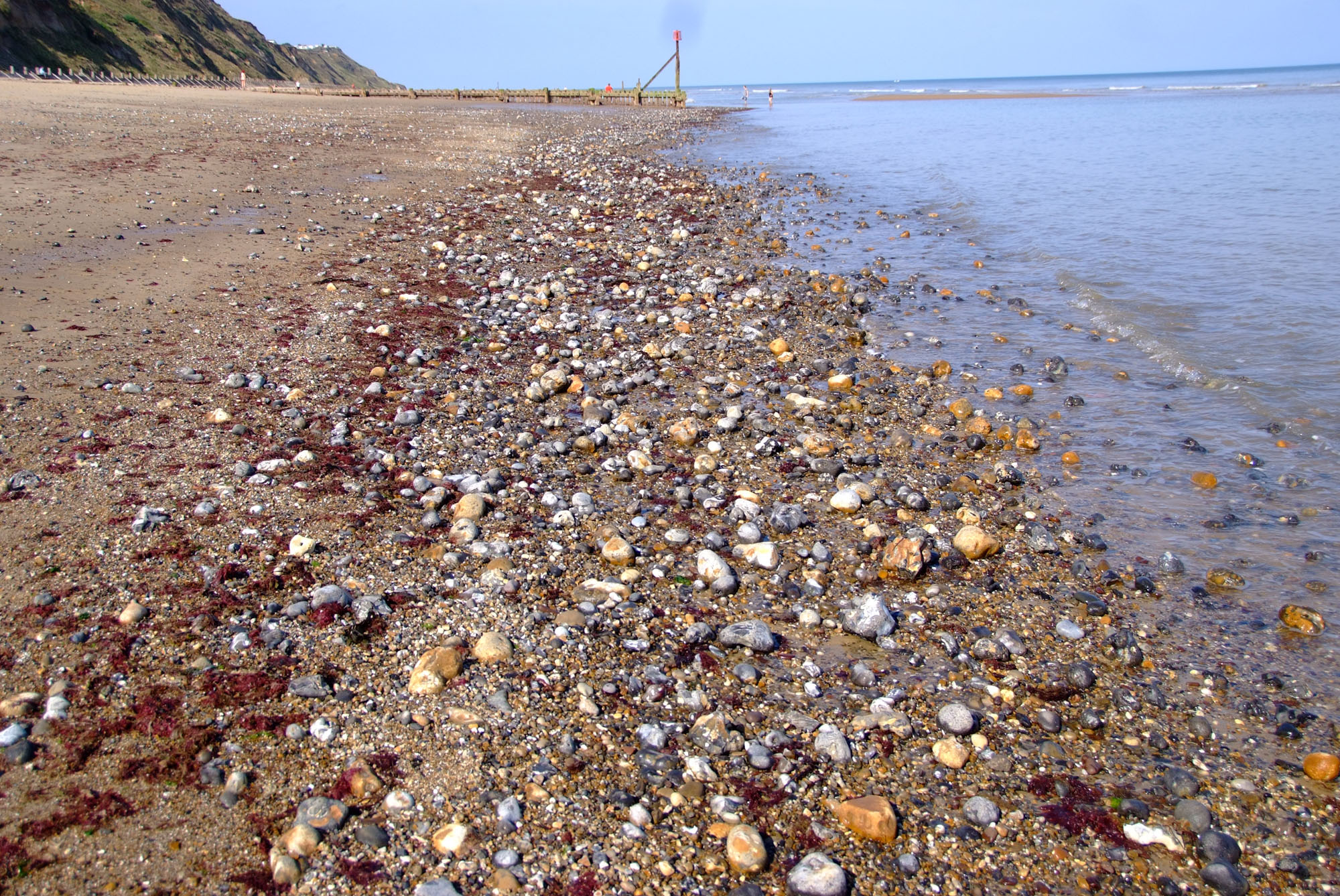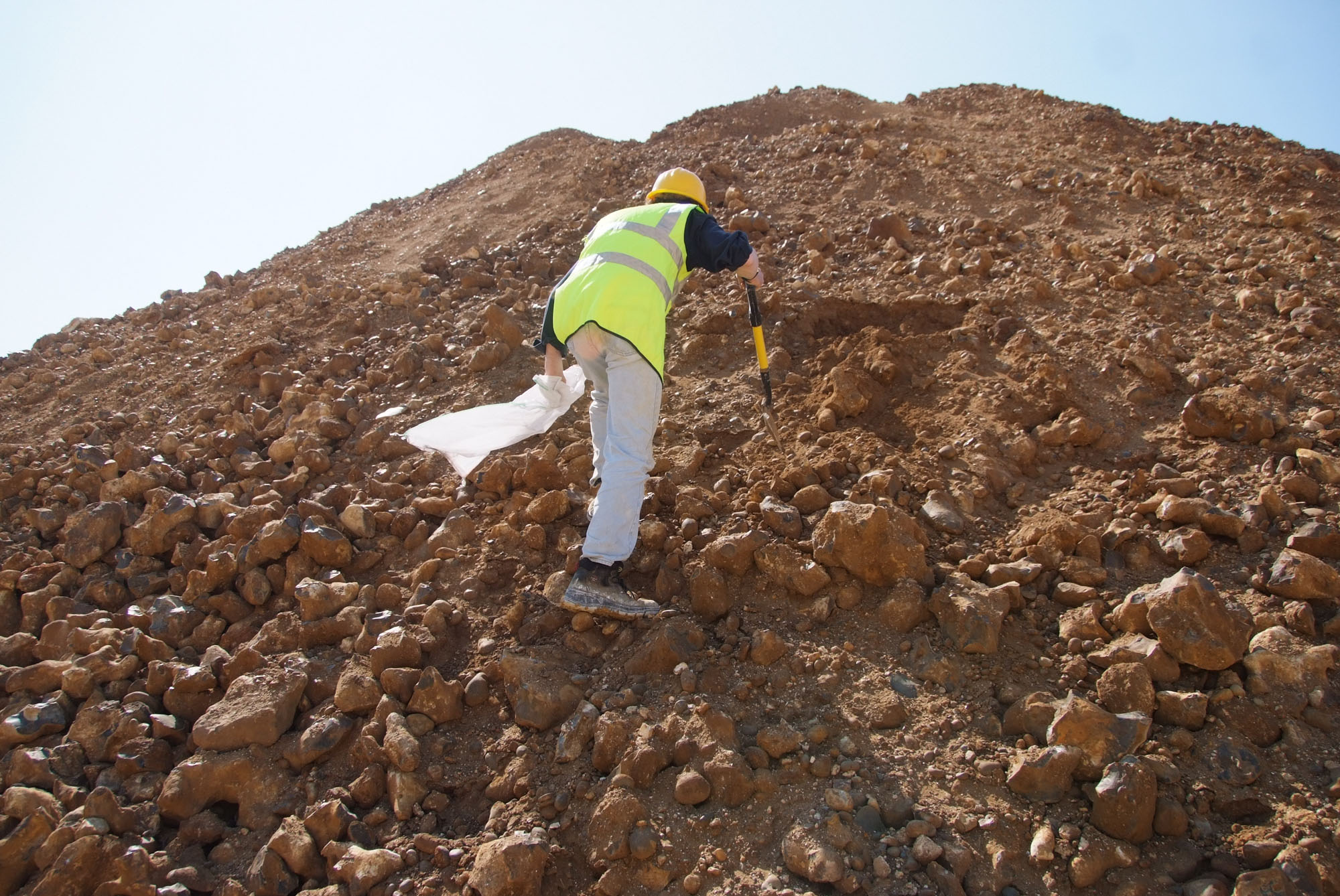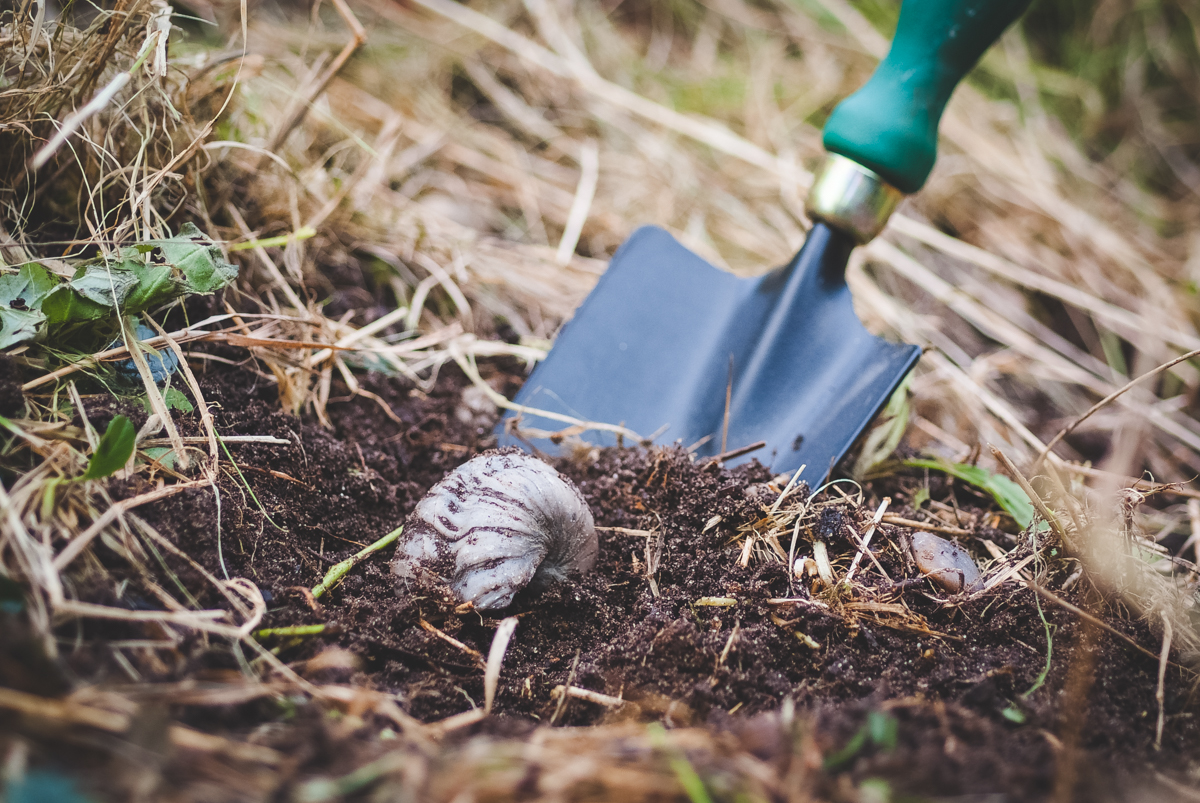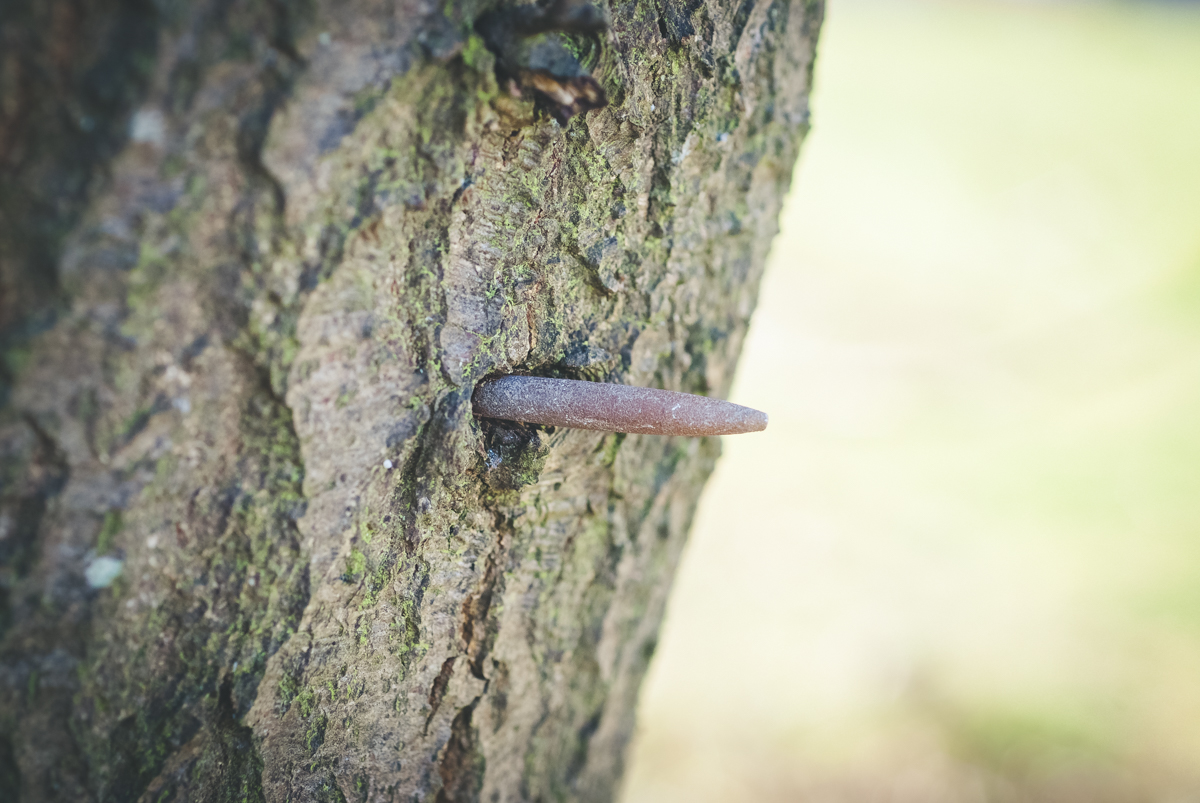Fossils can be found in many places. Most are found on beaches or in quarries, but many have been found in some very unusual places. Below is a list of places where you might find fossils. Note that some places, such as quarries and farm fields, need permission before you can enter, and if fossils form part of a construction, such as a sea defence and a wall, should not be touched. Damaging other people’s property is not only illegal, but morally wrong. Many people have used fossils to decorate walls and buildings for themselves and others to enjoy, so leave them alone and find your own.
On the Beach
On the Foreshore
The foreshore is the most common place to look for fossils and the most suitable for children. Generally, you can find fossils on most beaches, because they can be washed up from other locations. Flints can contain also fossils, even in those locations with sea defences or no cliffs.
For instance, Harwich is an excellent location for finding fossils but has no cliffs – the fossils are washed out from both the sea and below beach level. Bognor Regis and Charmouth Beach are also good examples of this type of location.

Amongst the Shingle
A good place to look on the foreshore is among the shingle. Fossils can be washed out of cliffs and from below beach level, and caught between the shingle on the beach. Harwich, Folkestone and Ramsholt are all fine examples of locations where fossils can be found in this way.

Under the Rocks
You should check under rocks and move stones or boulders, as most collectors will simply scan the foreshore looking for finds. However, sometimes you can discover an important find hidden away from view. Seatown in Dorset is a good example of such a location.

In the Cliff
Fossils can be found in the cliff too, but we do not encourage people to hammer or dig into the cliffs, as this can be very dangerous. Usually, you will have much more luck at finding fossils on the beach and under the cliffs where they have fallen or been washed out. Remember that, if you do search under cliffs, you must wear a hard hat and heed any warning signs about falling rocks and dangerous cliffs.
Normally, the best time to look is after a high tide. It is not normally worth digging, as you will have little chance of finding anything, but simply look for fossils poking out. Yaverland on the Isle of Wight is a fine example.

On the Tide line
A good place to look on the foreshore is on the high tide line. There are two reasons for this: firstly, you can find amber that gets caught in the seaweed; and, secondly, because smaller fossils may have escaped being seen by other collectors, but may be visible on this part of the foreshore. A good example of a location for amber is Southwold.

In the Scree Slopes
Fossils can fall onto scree slopes from the cliffs above. Check the bottom of these slopes, because fossils are normally heavier than the surrounding matrix and they tend to accumulate at the bottom of these slopes. An example of such a location is Hastings.

At a Quarry, Pit or Cliff Face
On the Quarry Floor
Quarries are a good source of fossils, with some much better than others. Make sure you have permission from the quarry owner and comply with their safety guidelines. Some quarries are currently being worked, but many others are now disused.
The quarry floor is a much safer area for collecting that the quarry face. Fossils can be found depending on what bed is exposed at floor level and a little digging can yield some nice finds without running the risk of cliff falls. An example of this is Caistor St Edmund’s, where the floor is quite rocky and the sponge bed is just below the quarry floor. Also note that your trusty mobile phone may not work at the bottom of quarries. Also note that quarries are not suitable for children, as many of them have pools of deep water at the bottom, with sheer sides.

In the quarry Face
Of course, fossils can also be found in quarry faces, but care must be taken and hard hats must always be worn. Avoid high cliff faces. In some disused quarries, the quarry floor will be overgrown, so looking in the cliff face is sometimes the only option. In other locations, such as those with crags, collecting from the cliff face is the only way. An example of such a location is Alderton.

In the Scree Slopes
Fossils can be found at the bottom of quarry scree slopes, where they have fallen out of the cliff face. An example to such a location is Upware, where fossils from the higher (unreachable) beds fall to the base of the cliff face.

In Spoil Heaps
Fossils can be found on quarry or pit spoil heaps, either inside or outside the quarry itself. For instance, at Radstock, the coal spoil heaps can be found at various locations, but the old coal pits have now been filled in. However, some very good fossils can still be collected from these heaps.

Other Locations
Along the river bank
Fossils can be found along river banks. For instance, the Bungay River has yielded some important finds in certain areas. Fossils can be washed up from the river bed or out of the bank. Some rivers have cliff faces and beaches, which are very similar to beach locations. Ramsholt and Aust are excellent examples.

In small Streams
Small, shallow streams, in areas of slow moving currents, can yield some excellent finds and fossils can travel for miles down these streams. For instance, streams in South Wales and the Lake District can yield trilobites, shells and other fossils.

Caught in a fishing net
Fishermen quite often ‘catch’ fossils. In fact, some of the biggest finds have been made by fishermen, especially at Great Yarmouth, Charmouth and the Isle of Wight.

On a farm field
Farms often are a good place to search for fossils. Years of ploughing lifts fossils to the surface of fields and this is particularly true for those areas where chalk is close to the surface. Of course, you do need permission before searching on farm land. Many farms have public footpaths and fossils can be found along these. Such an example is Shapwick Grange in Dorset.

In your own garden
Yes, fossils can be found in your own garden, if you are very lucky. They can occasionally work their way to the surface, especially if the fossil beds are not very far down. So, have you ever wondered what’s just below your feet? Some gardens in Beccles in Suffolk contain boulder clay similar to that which is found at Corton and Pakefield several miles away. Gardeners have reported that this layer is no more than half a meter below the surface. Perhaps now is a good time to go and dig that vegetable patch you’ve been meaning to get done for years, as you never know what you might find.

Deep Sea Trawling
In the North Sea, rich Pleistocene deposits yield vast numbers of mammalian remains, particularly mammoths. Boats originally accidentally found the bones while trawling for fish, but the same technique is now used to trawl for fossils, by people like Deposits contributor, Dick Mol from the Netherlands.

At a construction site
If you can obtain permission, a construction site is a perfect way to find fossils (in the right area of course). Many locations, where road construction cuts through hills and valleys or when digging the foundations for buildings, have all yielded some excellent finds. In fact, in Tokyo, dinosaurs are often found when digging the foundations for skyscrapers, and some amazing finds were made during the construction of the channel tunnel. Note that construction sites are dangerous places, and permission must always be sought and safety guidelines strictly adhered to.

Walls & Sea Defences
Fossils can also be seen (but not collected from) some walls and sea defences, especially the defences that collect together a range of rocks and wire them together. The problem is that it is hard to tell where they originally came from. Portland stone is a very popular building material, which can contain many fossils. However, don’t go knocking all the walls apart, otherwise you could make a few enemies and gain yourself a criminal record for vandalism in the bargain. Use a cameral instead.

Houses and buildings
Yes, fossils can even be found in building stones. There are many world famous buildings and statues in the world made from stone with fossils in. Sometimes, these are deliberately added, like a stone floor with fish fossils, or giant ammonites in the walls of buildings or cladding using Roach from the Isle of Portland, but most the time, the builders never even noticed they were there.

Landfills and dumps
Fossils can be found at landfill sites, as these are usually redundant quarries that are dug quite deep. Once again permission must be sought. At dumps, people also tend to throw away almost anything, fossils included, so get your local dump manager to keep an eye open for any that people have thrown away – you never know what may turn up.

Sticking out of a tree!
Yes, you can even find fossils sticking out of trees. Many years ago, belemnites were believed to have been lightning bolts, when found in tree trunks. But what really happened was that the tree had grown around the belemnite, bringing it out of the ground as it grew up and around it.


